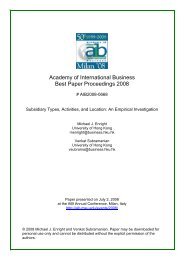AIB 2012 Conference Proceedings - Academy of International ...
AIB 2012 Conference Proceedings - Academy of International ...
AIB 2012 Conference Proceedings - Academy of International ...
Create successful ePaper yourself
Turn your PDF publications into a flip-book with our unique Google optimized e-Paper software.
TUESDAY<br />
evaluation, preference, and purchase intention regarding a product manufactured domestically, yet available<br />
both domestically and internationally. Specifically, consumers' product knowledge negatively moderates the<br />
COED effect on the quality evaluation <strong>of</strong> the car and mahogany furniture. This finding is similar to the halo<br />
effect in the country <strong>of</strong> origin (COO) literature. In addition, different export destinations have different effects<br />
on consumers' preference and purchase intention. In contrast to studies in the COO literature, this research<br />
demonstrates that nationalism and internationalism are positively related to the intention to purchase an<br />
exported product. Patriotism, however, is negatively related to the consumer's intention to purchase an<br />
exported product. (For more information, please contact: Shenyu Li, Shanghai University <strong>of</strong> Finance and<br />
Economics, China: li.shenyu@shufe.edu.cn)<br />
Competitive Brand Evaluation: Does Cultural and Linguistic Fit Dictate the Effectiveness <strong>of</strong> <strong>International</strong><br />
Branding Strategy<br />
David W. Pan, Prince Sultan University<br />
Linda D. Clarke, University <strong>of</strong> Florida<br />
Berna Mutlu, University <strong>of</strong> Florida<br />
Alan Pan, Xiamen University<br />
Consumers worldwide base their product/brand selection decisions upon their own "ethno-linguistic" contexts.<br />
An ethno-linguistic fit is therefore proposed and partially confirmed as a principle factor overriding brand<br />
effectiveness in determining effective international marketing strategies. Domestic and imported brands are<br />
compared on product-brand fit, brand-perception consistency, and brand-product/cultural-linguistic consistency<br />
in two nations with the following results: (1) The host ethno-linguistic function indeed serves an overriding<br />
factor for a foreign brand; (2) as long as a product and its brand do not conflict with the host ethno-linguistic<br />
norms, the foreign brand would be minimally sufficient to enter a market <strong>of</strong> a new ethno-linguistic context other<br />
than its own; (3) a transliterated brand that fits with the host ethno-linguistic context has potential in its host<br />
market that surpasses its brand equity in its home market due to the independency <strong>of</strong> a brand <strong>of</strong> a given ethnolinguistic<br />
context; (4) just being a foreign brand in a host market has its limitations in improving the brand<br />
equity rapidly; (5) consumers are more savvy with their own domestic brands and products by taking their<br />
consistency with their own ethno-linguistic context for granted than with foreign brands and their embodied<br />
products. (For more information, please contact: Linda D. Clarke, University <strong>of</strong> Florida, USA: clarkel@ufl.edu)<br />
Session: 3.3.12 - Interactive<br />
Track: 10 - Economics, Finance and Accounting<br />
<strong>International</strong> Competitiveness<br />
Presented On: July 3, <strong>2012</strong> - 13:00-14:15<br />
Chair: Joseph Clougherty, University <strong>of</strong> Illinois at Urbana-Champaign and CEPR-London<br />
How Does Export Price Competitiveness affect Geographic Diversification and Performance<br />
Dirk Michael Boehe, Insper Institute <strong>of</strong> Education and Research<br />
This paper tests a model that describes how export price competitiveness affects geographic export<br />
diversification and firm performance. The hypotheses were tested on a panel <strong>of</strong> Brazilian exporters covering the<br />
years from 2001-2010. Using a firm-specific real effective exchange rate index to operationalize export price<br />
competitiveness, we find an inverted U-shape relationship between export price competitiveness and geographic<br />
export diversification. We also find that export price competitiveness moderates the relationship between<br />
geographic export diversification and firm performance: diversification is positively (negatively) related to<br />
performance for less (highly) price competitive exporters. By introducing a firm-specific real effective exchange<br />
<strong>AIB</strong> <strong>2012</strong> <strong>Conference</strong> <strong>Proceedings</strong><br />
Page 236

















